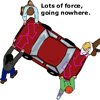|
Changing motion (Newton's 2nd
law)
"If a force acts on a body the acceleration it produces is
proportional to the size of the force and inversely proportional to
the mass of the body."
Like Newton's 1st law of Motion, the 2nd law
is concerned with the way moving objects behave. The 2nd
law has two parts, firstly it explains that the greater the force on
an object the greater will be its change in speed or velocity or acceleration.
The second part of the law states that for a given force, acceleration
is inversely proportional to the mass of the object.
In Newton's own words
(To be read only for historical insight. The mixture of old English
and terminology can confuse!)
The alteration of motion is ever proportional to the motive force
impressed; and is made in the same direction of the right line in which
that force is impressed.
If any force generates a motion, a double force will generate double
the motion, a triple force triple the motion, whether that force be
impressed altogether and at once, or gradually and successively. And
this motion (being always directed in the same way with the generating
force), if the body moved before, is added to or subtracted from the
former motion, according as they directly conspire with or are directly
contrary to each other; or obliquely joined, when they are oblique,
so as to produce a new motion compounded from the determination of both.
"Principia - 1726"
 Part
1 - more force for more acceleration Part
1 - more force for more acceleration
Ever tried pushing a car alone! Get some friends to help. "Many
hands make light work". Four people pushing a car will move it
easily, as long as they all push in the same direction. What would happen
if two push on the back and two on the front? Chances are the car would
not move! All are still pushing hard, but their efforts are cancelling
each other out.
Today we call "altering the motion", acceleration and any
change in motion, whether it be in speed or direction, is considered
an acceleration. Acceleration requires force and if you wish to increase
the speed of your car quickly you will require lots of force.
Acceleration is always in the same direction as the resultant force.
When two or more forces are exerted the addition of these forces will
change the motion of the body in the direction of the total force.
Part 2 - more mass, less acceleration
Pushing a bike is a lot easier than pushing a car, Newton's 2nd
law expresses this as "… the acceleration is inversely
proportional to the mass of the body."
For the same force, the heavier an object, the less will be its acceleration.
Put another way, to accelerate a massive object requires more effort
that a lighter object.
F = ma
By putting the two parts together the mathematical equation F = ma is
produced. This simply states that the force exerted on a body is equal
to the mass of the body multiplied by its acceleration. Mass is measured
in kilograms (kg), acceleration in metres per second per second (m/s/s),
and force in Newtons (N). A body with a mass of 1 kg, accelerating at
1 m/s/s, is being pushed by a resultant force of 1N.
|